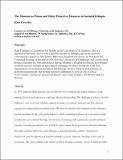Files in this item
The museum as prison and other protective measures in socialist Ethiopia
Item metadata
| dc.contributor.author | Cowcher, Kate | |
| dc.date.accessioned | 2021-03-10T00:39:26Z | |
| dc.date.available | 2021-03-10T00:39:26Z | |
| dc.date.issued | 2020 | |
| dc.identifier | 260926886 | |
| dc.identifier | f55a5a74-4d29-4f21-9300-ff14f05c82a7 | |
| dc.identifier | 85073786648 | |
| dc.identifier | 000485561200001 | |
| dc.identifier.citation | Cowcher , K 2020 , ' The museum as prison and other protective measures in socialist Ethiopia ' , International Journal of Heritage Studies , vol. 26 , no. 12 , pp. 1166-1184 . https://doi.org/10.1080/13527258.2019.1661270 | en |
| dc.identifier.issn | 1352-7258 | |
| dc.identifier.other | ORCID: /0000-0002-2157-1799/work/61622275 | |
| dc.identifier.uri | https://hdl.handle.net/10023/21576 | |
| dc.description | Research for this study was partially funded by the Centre for Advanced Study in the Visual Arts (CASVA) at the National Gallery of Art. | en |
| dc.description.abstract | In 1974 Emperor Haile Selassie was overthrown in a revolution that ended Ethiopia’s long Imperial history and ushered in a military Marxist dictatorship. The challenge of what to do with Ethiopia’s vast royal and religious cultural heritage–of symbolic national and Pan-African significance–immediately presented itself. This article considers the treatment of the Ethiopia’s historic heritages in the wake of the Emperor’s fall, examining both acts of iconoclasm and the proliferation of a cultural heritage bureaucracy in keeping with a putatively socialist political agenda. Focusing specifically on a UNESCO report about the proposed new National Museum, this study explores efforts to recast Ethiopia’s national narrative within a ‘progressive’ framework, and the influence of Leninist attitudes towards ‘imperial’ heritage in the wake of revolution. The latter evidences the impact of Soviet heritage concepts, known in Addis through the circulation of Progress Publisher books from the later 1970s onwards, and through educational sojourns by Ethiopian intellectuals to Soviet cities. Though the revolution was a destructive, iconoclastic process in which many (including the Emperor) lost their lives, it left a curious legacy regarding national cultural heritage, the very definition of which was dramatically expanded to include much more than royal crowns and Orthodox treasures. | |
| dc.format.extent | 454713 | |
| dc.language.iso | eng | |
| dc.relation.ispartof | International Journal of Heritage Studies | en |
| dc.subject | Socialism | en |
| dc.subject | Internationalism | en |
| dc.subject | Ethiopia | en |
| dc.subject | Soviet Union | en |
| dc.subject | UNESCO | en |
| dc.subject | NX Arts in general | en |
| dc.subject | T-NDAS | en |
| dc.subject | BDC | en |
| dc.subject | R2C | en |
| dc.subject | SDG 11 - Sustainable Cities and Communities | en |
| dc.subject.lcc | NX | en |
| dc.title | The museum as prison and other protective measures in socialist Ethiopia | en |
| dc.type | Journal article | en |
| dc.contributor.institution | University of St Andrews. Centre for Contemporary Art | en |
| dc.contributor.institution | University of St Andrews. School of Art History | en |
| dc.identifier.doi | https://doi.org/10.1080/13527258.2019.1661270 | |
| dc.description.status | Peer reviewed | en |
| dc.date.embargoedUntil | 2021-03-10 |
This item appears in the following Collection(s)
Items in the St Andrews Research Repository are protected by copyright, with all rights reserved, unless otherwise indicated.

